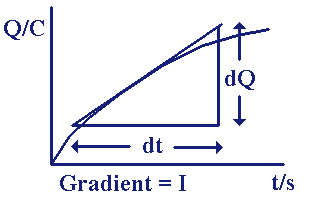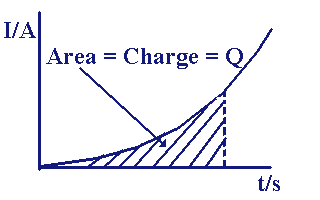| Physics
A - AS Module 3
Current
Electricity
Electric
Current and Electric Charge
- When
an electric current flows in a circuit, electric charge moves
around the circuit.
-
The bigger the current, the bigger the amount of charge which
passes each point in the circuit each second.
-
The longer the time that the current flows for, the bigger the
amount of charge which passes.
The
Coulomb (C)
- The
Coulomb is the unit of electric charge.
-
If a current of 1 Amp flows for 1 second, 1 Coulomb of electric
charge will pass.
-
If 2 A flows for 1 second, 2 C of charge will pass.
-
If 1 A flows for 3 seconds, 3 C of charge will pass.
-
If 2 A flows for 3 seconds, 6 C of charge will pass.
The relationship is:
Q
= I x t
charge
= current x time
Q is Electric Charge measured in Coulombs (C)
I is Electric Current measured in Amps (A)
t is time measured in seconds (s)
A simple way to express this is as follows
The triangle reveals the realtionship you want.

I
= Q/t
t
= Q/I
Q
= I x t
Charge and Electric Current
Current is the rate of flow of electric charge.
I
= dQ/ dt
Current
I is measured in Amperes (Amps).
Electric Charge Q is measured in Coulombs
The gradient of a graph of Q against t is the current I.

The area under a graph of I against t is the charge.

Electrical Potential Difference
Think of this as electrical potential ENERGY difference.
Potential Difference is the energy converted from Electrical Energy
per Coulomb of electrical charge which passes.
When 1 Coulomb of Electrical Charge moves through 12 V, 12 J of
energy are converted.
Potential Difference = Electrical Work Done / Charge Passed
V
= W/Q
OR W = Q x V
Power
Power is the energy transferred in each second.
Electrical power is the electrical energy transferred each second.
Power= Energy Transferred ÷ Time Taken
P = E/ t
The Units of Power are Joules per Second ( J/s)
1 Joule per second is called a Watt (W)
1 J/s = 1 W
But
also
Energy Transferred = Charge x Voltage
E = Q x V
And so
Electrical Power = (Charge x Voltage)÷ Time Taken
P = (Q x V) / t
But
Charge / time taken = Electric Current
Q/t = I
And so the expression for Electrical Power becomes
Power = Current x Voltage
P = I x V
|


